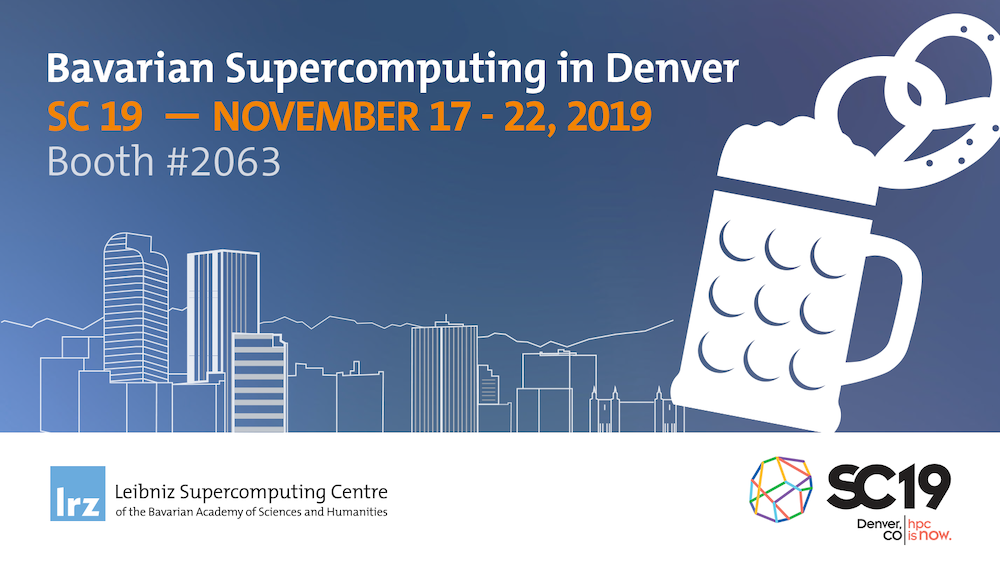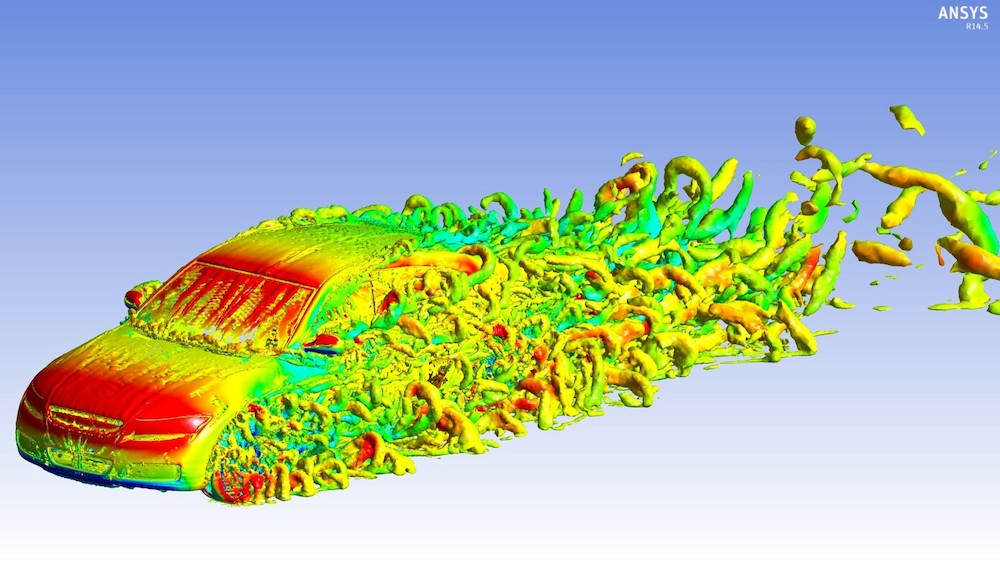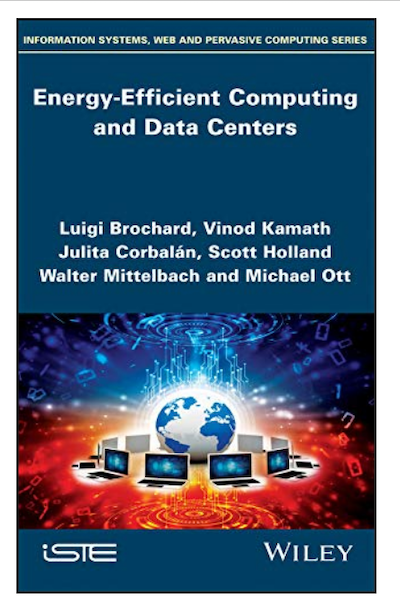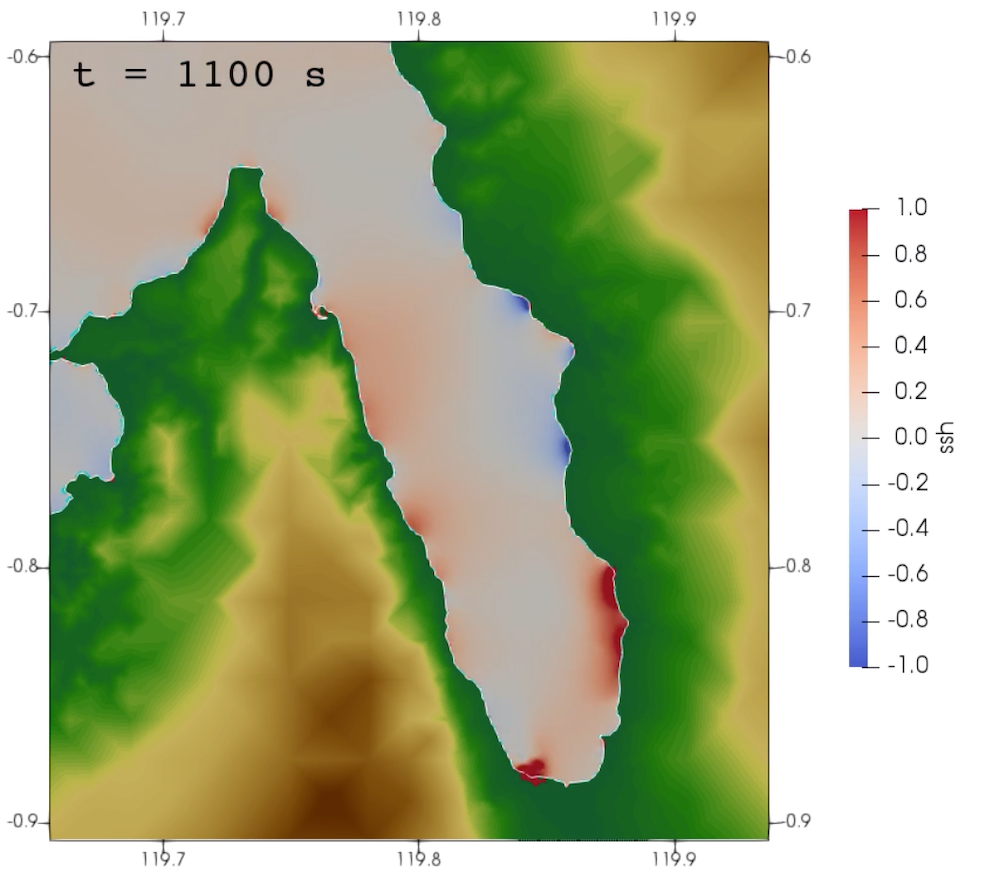LRZ-Newsletter Nr. 11/2019 Nov 14th 2019

You will find this newsletter in German on the LRZ-website
Our Topics:
- News
- Workshops and Events
- Equipment to Give Away
- Job Opportunities
- More to Read
- Informations about the LRZ Newsletter
- Imprint
News

Bavaria's Exports for Supercomputing
Stickers and bags are printed, the MaiMUC, a maypole of ten credit card-sized Raspberry Pi computers, is currently being packed at the Technical University of Munich (TUM), the last talks and presentations are in preparation: SC19, the world’s premier supercomputing conference, starts in Denver at the end of the week. The Leibniz Supercomputing Centre (LRZ) shows a strong presence in the conference program and will host the Bavarian Supercoputing Alliance (BSA), representing five Bavarian universities and data centres, at its booth 2063.
In lectures and discussions, the BSA team of more than 20 experts onsite will showcase their expertise and export Bavarian knowledge on systems, software and science: "From energy efficiency to monitoring to artificial intelligence, we are working as a team on important topics and delivering practical solutions," says Professor Dieter Kranzmüller, Director of the LRZ. In addition to Bavaria's largest computer center, the Ludwig Maximilian University (LMU), the TUM, the Friedrich Alexander University (FAU), the regional computer center Erlangen (RRZE) as well as the University of Regensburg and the Deggendorf University of Applied Sciences will be represented in the BSA team during SC19 at booth 2063.
Useful Tools for Supercomputing
Not only the TUM-MaiMUC will attract visitors at the white-blue designed booth 2063. The maypole of mini-computers is a pretty Bavarian exhibit and embodies a multicore computer at the same time. Equipped with LED screens, an Intel Movidus USB stick for machine learning and cameras, the MaiMUC will evaluate visitor numbers and preferences at the booth: artificial intelligence and pattern recognition in small scale. In addition to research results on the performance of new interfaces for HPC or on the use of artificial intelligence, the BSA will also be carrying tools such as the Data Center Data Base (DCDB) and LIKWID from Erlangen, with which data centers can improve the utilization of their computers and scientists can better adapt applications.
Stunning images from space
One of the highlights is certainly the sensational images from space with which the astrophysicists Salvatore Cielo and Luigi Iapichino together with the visualization team of the LRZ illustrate the birth of stars. The impressive three-minute film competes for the best six visualizations in HPC. Even more Bavarian presence at SC19: Arndt Bode, former director of the LRZ and computer science professor (emeritus) at TUM, is chairman of the jury for the prestigious Gordon Bell Prize in 2019, which honors outstanding research in HPC.
Excellent young HPC scientists from Bavaria
Last but not least, teaching requirements in Denver will be discussed at the BSA booth. Six FAU doctoral students from Erlangen will take part in the student cluster competition. Team "DeFAUlt" will not only solve practical HPC problems in Denver, but will also present and defend their project in a talk at the show. For more information on the BSA team at Denver and the SC19, please visit the new website bavariansupercomputing.de – going live shortly before the show. (vs)
More Licenses, more Computing Power
The ANSYS software has been in use at the Leibniz Supercomputing Center (LRZ) for years: On SuperMUC the software was limited to about 3500 cores, for the new SuperMUC-NG the number of licenses has been extended. With the support of CADFEM, a service provider based in Grafing near Munich, the simulation software now runs on more than 18,000 cores: "We were able to more than quadruple our license portfolio, so that now either more users can work with it simultaneously or significantly larger problems in the fields of numerical fluid mechanics and structural mechanics can be solved," explains Thomas Frank, expert for High Performance Computing (HPC) at the LRZ in Garching.
Simulating flows
ANSYS is a software package of about 20 programs and applications with which engineers and scientists simulate and analyze complex questions and technologies on the computer. In HPC in general–just like at the LRZ– researchers adopt primarily the CFX and Fluent applications of ANSYS. These tools are used when the flow properties of gases, liquids, fluid mixtures and multi-phase flows are to be represented in two or three dimensions, for example to assess the design of turbines, to develop new rocket propulsion systems or to improve the aerodynamics of vehicles. The image was produced with ANSYS and shows air turbulence of different magnitudes on a car model.

Often in use
At the LRZ, ANSYS is one of the most widely used commercial software programs. More than a quarter of the compute hours used on SuperMUC were spent on Computational Fluid Dynamics (CFD) in the last six years. ANSYS is updated approximately every four months, most recently in September 2019.(vs)
Experiences for Energy Saving in Data Centres

Save power with data: The Leibniz Supercomputer Centre (LRZ) consumes about five megawatts of electricity, up to four of which flow into the SuperMUC-NG. In order to use them as efficiently as possible and even reduce consumption in the future, the LRZ is already relying on an innovative cooling system with hot water and is researching even more ways of saving electricity. A book - the title: Energy-Efficient Computing and Data Centers – has now been published on the strategies to increase the energy efficiency of high-performance computers and data centres, incorporating experience from the LRZ. December 11th 2019 editor Luigi Brochard will be a guest at the LRZ to discuss these issues. An interview with Michael Ott from the LRZ about energy-efficient high-performance computers:
Why is the energy consumption of data centers an issue for research & development - and also for a book?
Dr. Michael Ott: Because computers and computer systems in particular consume a lot of electricity. Data centers also want to contribute to sustainability and resource conservation. However, manufacturers or economically operated data centers are usually involved in such tight processes that they lack the time to experiment. But interest in energy efficiency is high, as the book "Energy -Efficient Computing and Data Centers" clearly shows. It was written on the initiative of Luigi Brochard, a former IBM and Lenovo employee, In collaboration with various scientists, Brochard has gathered initial approaches to saving electricity in data centers.
Who should read the book and why?
Ott: Computer manufacturers certainly find inspiration in it, but so do the operators of data centers, and many computer scientists and data specialists are certainly interested when they realize that their work on computers consumes a lot of electricity.
You lead the data analysis team within the international Energy Efficient HPC Working Group and work on solutions to reduce power consumption in data centers.
Ott: With the working group we are researching all operating parameters for high-performance data centers. In short, it's about collecting and analyzing data anywhere and then adapting workflows and systems to improve energy efficiency. At the LRZ, we have developed an open source monitoring tool for this purpose: Data Center Data Base oder DCDB. It collects data from various sources, which we will soon evaluate and would like to use to optimize the systems. The next step will be to have such data evaluated by artificial intelligence in order to automate the system adaptation later on.
Supercomputers like the SuperMUC-NG of the Leibniz Computing Center consume 3.4 megawatts in peak – where can you start to reduce power consumption?
Ott: Technically, the systems are exhausted, processors and computer cores are already working economically and for their cooling, one of the biggest energy guzzlers, there are already very good solutions. At the LRZ, we are working with an adsorption chiller system with which the waste heat from SuperMUC-NG can be used to air-condition the data center. But only little happens with the software. If applications are better adapted to the computers and their performance, their power consumption decreases. First tools such as "Energy Aware Runtime" (EAR) lower the clock rates when they are not completely needed. It would also be conceivable to better organize and coordinate computing jobs in order to increase their throughput. In return, we expect many more suggestions from monitoring and DCDB.
Are there any initial findings from the open source program Data Center Data Base?
Ott: We are currently busy installing the monitoring program on the SuperMUC-NG and making it known at congresses like the ISC in Frankfurt or soon at the SC2019 in Denver in order to gain more users. (Interview: vs)
FAIR Research data
Making information findable, visible and usable: This was one of the central topics of the Open Search Symposium, which took place at the end of October at the Leibniz Supercomputing Centre (LRZ) under the auspices of the Open Search Foundation. Above all, scientific data should be FAIR, i.e. findable, accessible, interoperable and reusable. To this end, the LRZ is working on several projects, one of the aims of which is to establish a management system for research data: "Our focus is on making data from High Performing Computing FAIR. Data sets from supercomputers often comprise several hundred terabytes of information, are therefore rather immobile and cannot be stored in classical repositories," says Stephan Hachinger, PhD in physics, explaining the basic problem. "This results in data silos with the data not being exchanged or used for any other purpose. These silos contain information that could be of great use for other projects.

A management system for research data
The LRZ’s "Research Data Management Team" is currently working on setting up a system that will allow research data from various LRZ systems, such as the SuperMUC-NG, to be found: "We are equipping data records with metadata such as titles, authors, and keywords in order to prepare them for search engines," explains Alexander Götz. The resulting information is also assigned an identification number, the Digital Object Identifier (DOI), which, like an ISBN number in books, leads to individual titles or data records. Ideally, the information belonging to the DOI is collected on a website and provides the link to the data record. And, of course, the data should also be machine-readable with the help of interfaces and thus be able to be collected by search engines. Search portal projects such as EUDAT-B2FIND at European level or Generic Research Data Infrastructure (GeRDI) at national level are already using these techniques. The Research Data Management team and the LRZ were actively involved in GeRDI.
Containers, services and interfaces for data exchange
What sounds simple requires technical effort: Only with the cloud, containers and microservice-based architectures is it possible to expand a system that is both flexible and powerful enough to meet the requirements of supercomputers and storage systems at the LRZ. "This is just the beginning," says Hachinger. "But we hope to be able to derive further services for the LRZ and its research clientele from the Research Data Management System.
LEXIS, an EU project with LRZ participation that deals with workflows of supercomputers within cloud systems, is also concerned with the accessibility of large data sets: Besides the goal of FAIRness, the focus is on a system for distributed data storage based on EUDAT-B2SAFE. This "Distributed Data Infrastructure" is intended to provide uniform access to data from all participating European computer centres, regardless of storage space and the institution accessing it. The current status of these efforts as well as the Research Data Management System of the LRZ were presented at the Open-Search-Symposium in posters and talks.
Uniformity required
"The findings slumbering in data repositories today could be used much better in the future if there were uniform interfaces and protocols for access", Götz is certain. The Research Data Alliance (RDA) will soon be looking into what this could look like: Together with experts from the American National Institute of Standards and Technology (NIST), the data specialists from the LRZ presented ideas and other tasks for teams at this year's RDA 14th Plenary in Helsinki at the end of October. (vs)
Tsunami Puzzle Solved
Digital simulations help to understand the world: an international team of scientists led by Munich geophysicist Dr. Alice-Agnes Gabriel and PhD student Thomas Ulrich have succeeded in solving the mystery of the Sulawesi tsunami 2018 at the Leibniz Supercomputing Centre (LRZ) in Garching. The mysterious tsunami was triggered not by the landslides on the steep shores of Palu Bay, as expected, but by extremely rapid tearing movements of the seabed and the special tectonics of the bay: "The tidal wave triggered by the tsunami must have piled up in the narrow bay like in a bathtub", Gabriel explains groundbreaking research results, which are now often reported and much discussed.
A catastrophe surprises research
In September 2018, first an earthquake shook the Sulawesi region of Indonesia, followed by a tidal wave in the narrow, long Palu Bay on the west coast. 4000 people died as a result of the disaster, 14,000 were injured. Earthquakes are actually nothing unusual in this area, but nobody could explain the following, heavy tsunami. Usually tidal waves occur after vertical faults of the earth, but not after horizontal earth movements as observed in Sulawesi.
Coupled Simulation Lay a Trail
For the exploration of the tsunami in Palu, Gabriel and Ulrich's team, who both research and teach at the Ludwig-Maximilians-Universität in Munich, not only evaluated data from comparable catastrophes, they also combined different simulations of earthquakes and tsunamis with each other and found step-by-step the solution to the mystery in the newly created spatial images. The results have now been documented in writing; interested parties can also use the Zenodo science platform to find out which data was used and processed for the simulations, and they can also find various two-dimensional simulations there to reproduce the natural phenomena. "We hope that our study will contribute to a better understanding of the tectonic conditions and earthquake dynamics that could favour local tsunamis in similar fault zones," says geophysicist Thomas Ulrich. The more researchers understand these relationships, the more effective forecasts and early warning systems will become.(vs)

Securing data: 2 new research projects started at LRZ
Two new research projects have started at the Leibniz Supercomputing Centre (LRZ)recently. In both, LRZ acts as a technical partner and service provider with a focus on the security and provision of data: QuaSiModO, the abbreviation for Quantum-Secure VPN Modules and Operation Modes, is active in the field of encryption technology and cryptography and investigates systems and procedures for protecting networks, data centers and data exchange from hacker attacks in the current quantum age.
Quantum technology can endanger security
The background to this is the realization that the new calculation model of a quantum computer so substantially endangers all currently used encryption methods such as RSA that even key sizes of several gigabytes and terabytes no longer offer sufficient protection. Although there are no market-ready quantum computers yet, experiments with the technology are being carried out everywhere. This year, Google and IBM succeeded in solving a problem with a quantum computer and thus for the first time experimentally proving the so-called "quantum supremacy".
Under the coordination of genua GmbH, a data and cyber security specialist based in Kirchheim near Munich, the LRZ together with the Fraunhofer Institute for Applied and Integrated Security (AISEC), the Ludwig Maximilian University (LMU) and the network specialist ADVA, will search for better encryption methods over the next three years. The current NIST standardization process for new, so-called post-quantum algorithms forms the basis; the aim is to develop practical and trustworthy standardized algorithms for use in secure VPNs. At the first kickoff meeting at the end of October, the project was also integrated into the Bavarian Quantum Computing Exchange initiative, which is currently being formed at the LRZ and meets every second Wednesday of the month. The QuaSiModo project is funded by the German Federal Ministry of Education and Research and will run until August 2022.
Improving medicine with data
For CompBioMed the financial support comes from the European Union and from the Horizon2020 funding programme for research and innovation. The project started in 2016, is now entering its next phase and is dedicated to the collection, evaluation and use of medical data: High Performance Computing (HPC) is at the heart of this process. In recent years, around 50 partners from research, industry and hospitals have already developed various computer programs, algorithms and smart systems for the analysis and visualization of image and statistical data on cancer, heart and other diseases and are now focusing on enriching the everyday lives of scientists and physicians, helping to improve therapies and medical care and thus changing healthcare systems sustainably.
CompuBioMed focuses on training, information and consulting as well as the development of new services. Scientists and physicians are to become acquainted with HPC procedures and methods, with which they can tackle complex medical questions themselves and create and solve their own data projects. The LRZ provides data storage in the project and adapts existing software or algorithms to the specific needs of medicine. (vs)
Workshops and Events
Standards for Interfaces Sought
The eighth international workshop around the interfaces OpenCL, SYCL, Vulkan and Spir-V, called IWOCL, will take place from April 27th to 29th 2020 at the Leibniz-Supercomputing Centre (LRZ) in Garching near Munich. Computer specialists and engineers dealing with these programming interfaces are now invited to submit field reports on the integration of these interfaces into supercomputing projects as well as proposals for their extension or standardization. The interfaces accelerate and optimize the integration of applications on special processors, such as GPUs or accelerators. They will be important for the development of the next generation of high performance computers, the Exascale computers, which will certainly no longer be able to do without accelerators. The LRZ organizes the event and is involved in the selection of presentations and papers.
C++ for Beginners
Programming languages such as C++ are tools to help you think and plan workflows in a systematic, logical, and consistent way. C++ contains many language features and comprises different paradigms such as precedural or object-oriented programming. This 5-days course from Novembre 25th to 29th 2019 covers an introduction into the C++ language features, the paradigm ideas, software development process including program design, project management, debugging, and more. Course participants should have basic UNIX/Linux knowledge and basic knowledge on other programming language like C, java or other object oriented language. The lecturers Carmen Navarrete and Martinn Ohlerich holds this course in English.
Python for Beginners
As a general-purpose programming language with a growing user-base, Python is increasingly used by many scientists in their daily workflows. In this course we will cover all the fundamental concepts of programming: functions, data types, loops, conditionals, data structures, objects, and methods, in order to empower participants to use Python for their everyday programming needs. The course is for complete beginners to Python and programming in general. The lecturer Sheila Roessle-Blank holds this course in English.
Node Level Performance Engineering
December 3rd and 4th this course covers performance engineering approaches on the compute node level. Even application developers who are fluent in OpenMP and MPI often lack a good grasp of how much performance could at best be achieved by their code. This is because parallelism takes us only half the way to good performance. Even worse, slow serial code tends to scale very well, hiding the fact that resources are wasted. This course conveys the required knowledge to develop a thorough understanding of the interactions between software and hardware. We introduce in this PRACE course the basic architectural features and bottlenecks of modern processors and compute nodes. Pipelining, SIMD, superscalarity, caches, memory interfaces, ccNUMA, etc., are covered. We also show how simple software tools can be used to acquire knowledge about the system, run code in a reproducible way, and validate hypotheses about resource consumption. The lecturers Professor Gehard Wellein and Georg Hager hold this course in English.
Molecular Modeling with Schroedinger Suite
The LRZ Staff together with software experts on the Schrödinger Suite will conduct a workshop at the LRZ from Dec. 04 to Dec.05. 2019. The Workshop will cover fundamental principles of molecular modelling with an emphasis on molecular dynamics. We will introduce several MD software packages and how to use them on HPC systems and the Remote Visualisation Server of the LRZ. The workshop addresses people with a basic understanding of molecular simulations, e.g. nano-scientists, biologists, physicists or researchers from life-sciences. The experts will present the Schrödinger software suite, providing a diverse set of tools for modelling and computing the structure and properties of chemical systems, antibodies and proteins.
Excel for Advanced Users
Klaus Leschhorn shows the participants how to create Excel diagrams, sort data and edit tables with the probably best known spreadsheet program. Excel and its design possibilities is part of the basic training for prospective computer scientists. The course in German is also open to employees of the Leibniz Supercomputing Centre, who have already completed the previous units.
Google Cirq Bootcamp
There are different quantum computer languages, frameworks and toolkits with different programming styles and target groups. For the first generation of quantum computers, Google Cirq may be the most NISQ-focused framework, allowing physicists and computer scientists to control how calculations are performed and adapt the framework to specific skills or architectures. Cirq will also be the interface to the Google Cloud machine. Participants in this first Cirq course on December 16th will be introduced to the various functions, while Google lecturer Alexandru Paler will hold the boot camp in English. More informations to Cirq you and the bootcamp will find on Google's site.
Equipment to Give Away
The LRZ separates from used printers. Students, lecturers or employees of the universities and authorities report their interest by 25 November 2019 at the following e-mail address <althardware@lrz.de<. We will be happy to contact you.
Equipment to give away:
- Printer Xerox Phaser 5500 DTM, from 2006
- Printer Xerox Phaser 7400, from 2006
Job Opportunities
The following positions are currently open at the LRZ. You will find a diverse, international team in Garching. Most job offers are in German – for questions you will find English speaking colleagues here. Don't hesitate to e-mail or phone:
- IT-Specialist Medical Informatics and E-Health
- Research Assistant for Virtual reality
- Clerk for the Segment Taxes
- Student Assistant: Web-Frontend-Development
- Student Assistant for Human Ressources
You haven't found anything suitable? We look forward to unsolicited applications.
You will find all current job offers on our website:www.lrz.de/wir/stellen/.
More to Read
Here you will find links to the latest information from the German
and European supercomputing community and our cooperation partners:
- Publications of the Gauss Centre for Supercomputing (GCS): GSCnews 25/2019, InSIDE Autumn 2019
- Infoletters of the Gauß-Allianz (in German): November 2019 (PDF)
- PRACE: Newsletter
Informations about the LRZ Newsletter
- The LRZ Newsletter is published in German and English. You can find the latest editions on the website.
- You have problems displaying the newsletter? Please send a short description of your problem to <NewsletterRedaktion_AT_lrz.de>. Thank You.
- You can subscribe or unsubscribe the LRZ-Newsletter via our website.
- Previous issues of the LRZ-Newsletter can be found in the archive.
Imprint
- Editor:
- Leibniz Supercomputing Centre of the Bavarian Academy of Science and Humanities
- Adress:
- Leibniz Supercomputing Centre of the Bavarian Academy of Science
and Humanities
Boltzmannstraße 1
D-85748 Garching - Phone:
- +49-89-35831-8000
- Telefax:
- +49-89-35831-9700
- E-Mail:
- lrzpost_AT_lrz.de
- Editorial Office:
- PR-Team
